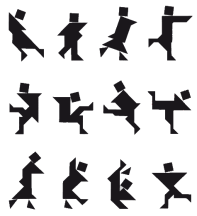Seven pieces. Simple on the surface but, with a willingness to dive below, seven pieces that hold an endless array of possibilities. One moment they can be a crane, next a gate, then a lio
n. From China in the early 1800’s, tanagrams have intrigued puzzle fans. There are now over 6,500 puzzles to solve from these seven simple pieces.
Today’s tale is of three of these pieces that wove their magic and a boy in a classroom. A boy with wirey glasses and hair to match. A boy with freckles on his nose and a problem to solve. We sat side by side and and began. I presented him with a square
with dark lines drawn to divide it into seven simple pieces. With scissors pulling to and fro, the pieces came apart falling into a scattered s
tack. Next, some fun explorations….two triangles make a square. Or is that a diamond? Two triangles make a bigger triangle. Parallelogram and trapezoid were new shapes to learn and new words to wrap around the tongue.
We moved from two pieces to three pieces connecting and exploring. We made a rectangle and a parallelogram. Each time, my teacher brain quickly seeing the solution and then guiding my young friend to make the discovery. And then it happened.
Three pieces, 4, 5 and 6. “Please use them to form a trapezoid,” the paper said. My teacher brain mentally flipped and rotated them. Um…well. Hmm. My brain flipped more, rotated more. My freckled friend’s fingers flipped and rotated the three pieces as well. His eyes lifted in an expectant gaze for a clue as to what to do. Together we were stumped. We called over another teacher to puzzle with us. Three minds working on three pieces. Still nothing. We called over another teacher to help. Four minds working on three pieces. Seriously. We’ve got this! Nope. Nothing.
We all paused not sure what to do. We’d run out of adults to ask. Then my puzzle partner innocently said, “Let’s ask Google!” A burst of laughter was followed by three
teachers reaching for their iPhones. A flurry of keyword searches was met with mumbles of, “nope, not here. Not possible. Must be a typing error. Maybe we should just skip it.”
Meanwhile, the boy looked at the pieces and looked at the pieces. He continued to try this and that. Suddenly, he leapt from his desk shouting, “I’ve got it!” And, indeed he did! Three teacher brains and three iPhone Google brains were bested by a small boy. A boy that didn’t give up. Oh I so want to save a snapshot of that moment in my mind forever. That smile on his face. That glow in his eyes. That pride. Oh.
What I’ve not shared with you in this tale so far is that this boy is special. This boy is in a classroom for children who share a label of ED. Emotionally Disabled. This boy struggles greatly with his emotions and is prone to outbursts of frustration with the smallest of things. This boy i
s not able to be part of a traditional classroom because of his challenges. But this boy. This boy is amazing! His emotional challenges are one piece of his puzzle. The other pieces show him to be intelligent, funny, determined, creative, artistic. Amazing.
Is this not true for us all? Do we not all have pieces of our puzzles that we love for others to see and those pieces that
we like to knock off the table and hide under the rug? How wonderful would it be for us to each show ALL our puzzle pieces and be loved no matter what? To show our puzzle pieces and know that others will walk alongside us and help us place those hard to fit pieces? Today I’m thankful for a boy and a three piece trapezoid that taught me to celebrate all of my puzzle pieces and to seek out and celebrate the unique puzzles all around me with all their amazing pictures just waiting to be connected.